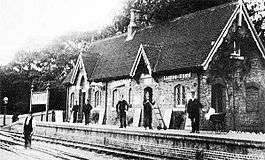Rowfant railway station
| Rowfant | |
|---|---|
|
Rowfant station c1890 | |
| Location | |
| Place | Rowfant |
| Area | Mid Sussex, West Sussex |
| Grid reference | TQ325368 |
| Operations | |
| Pre-grouping | London, Brighton and South Coast Railway |
| Post-grouping |
Southern Railway Southern Region of British Railways |
| Platforms | 2 |
| History | |
| 9 July 1855 | Opened |
| 7 January 1961 | Goods facilities withdrawn |
| 2 January 1967 | Closed to passenger traffic |
| Disused railway stations in the United Kingdom | |
|
Closed railway stations in Britain A B C D–F G H–J K–L M–O P–R S T–V W–Z | |
|
| |
Rowfant was a railway station on the Three Bridges to Tunbridge Wells Central Line in the parish of Worth, West Sussex.[1] The line closed in 1967, a casualty of the Beeching Axe. The route of the railway line cut a path through the estate of Curtis Miranda Lampson, a wealthy American fur trader and vice-chairman of the Atlantic Telegraph Company, who agreed to sell his land cheaply to the London, Brighton and South Coast Railway (LBSCR) on condition that a station be provided, together with the right to stop trains on request. Apart from Lampson's Rowfant House the only other nearby residence was Worth Hall owned by John Nix, an LBSCR director. At Lampson's request a shelter was provided for his coachmen.[2][3]
Train services
Rowfant, initially the only intermediate station between Three Bridges and East Grinstead, saw an initial service of six passenger trains per day, with two on Sundays. By 1859 this had increased to nine services with one early morning goods train, and four Sunday services. The opening of another intermediate station in 1860, Grange Road, saw passenger trains cut to six on weekdays. An additional siding and crossover were provided in 1878, the siding serving a nearby brickworks. The station was further enlarged in 1900-1901 when it became a crossing station with a new 500 ft. Up platform and footbridge. In 1906 the introduction of new motor carriages led to an increase in weekday services.[4]
Closure
Nevertheless, Rowfant saw very little passenger traffic and jointly held with Kingscote the record for the least revenue for passenger journeys on the LBSCR.[2] Although it saw a brief revival in terms of freight traffic when Gatwick Airport opened in the late 1950s and jet fuel was stored in the goods yard, its days were numbered and it closed with the rest of the line in January 1967 under the programme of closures put forward by local resident and British Rail Chairman, Richard Beeching.
The site today
Today the majority of the station survives, with the station site and goods yard occupied by a company producing road-building materials, Colas Limited. The station building, stationmaster's house and part of the Down platform survive. The Worth Way, a public footpath following the line of the railway, runs alongside the north face of the station building which is currently disused with its windows and doorways bricked up.[2]
| Preceding station | Disused railways | Following station | ||
|---|---|---|---|---|
| Three Bridges | British Rail Southern Region Three Bridges to Tunbridge Wells Central Line |
Grange Road | ||
See also
References
- ↑ "Parishes - Worth | A History of the County of Sussex: Volume 7 (pp. 192-200)". British-history.ac.uk. 1935-06-18. Retrieved 2013-08-04.
- 1 2 3 "Rowfant railway station on Subterranea Britannica". Subbrit.org.uk. Retrieved 2013-08-04.
- ↑ "Rowfant Grange". Early-lbscr.co.uk. 2007-04-13. Retrieved 2013-08-04.
- ↑ Gould, David (1983). Three Bridges to Tunbridge Wells. The Oakwood Press. ISBN 978-0-85361-299-5.
External links
Coordinates: 51°06′55″N 0°06′35″W / 51.1152°N 0.1097°W
